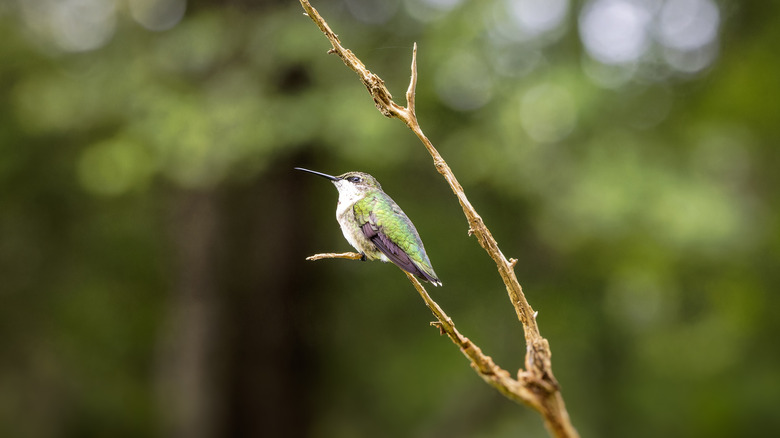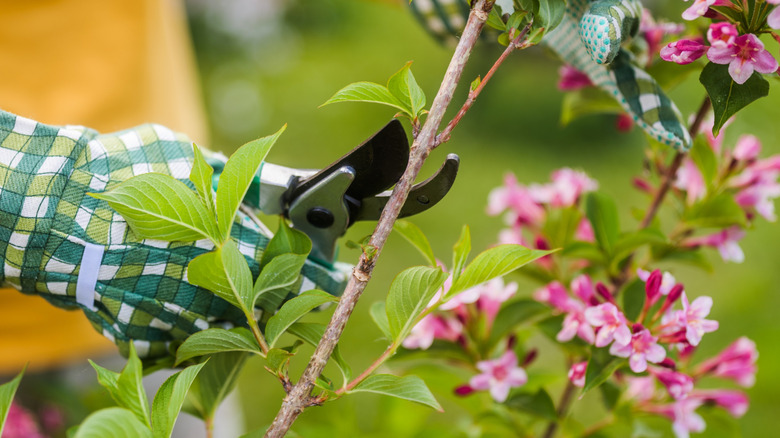Grow Your Hummingbird Garden By Propagating This Shrub In The Winter
Just because cold winter weather is coming, it doesn't mean you should stop thinking about the pollinators that will visit your garden in spring. Hummingbirds rely on nectar-filled, trumpet-shaped flowers for nutrients, and weigela (Weigela florida) provides exactly what they need. The shrub's combination of beauty and function is a big reason why it makes the perfect foundation plant for your home. The beautiful flowers come in pink, red, and white, and many weigela cultivars have variegated or anthocyanin-hued leaves that catch the eye even when the plant isn't blooming. Weigela is resilient, growing well in USDA Hardiness Zones 4 to 8, although some newer cultivars may survive outside this range.
If you are already growing a weigela you love, winter is the time to get more shrubs. Take hardwood cuttings, and you can grow a duplicate of the original plant — with the exact flower color and growth habits. This method allows you to expand your hummingbird garden without spending any money. Waiting until the stems are woody and the plant is dormant is the key to creating new weigela shrubs. It's a practical winter garden project that guarantees new additions to your pollinator yard, ready and waiting for the hummingbirds that return in the spring.
How to clone your favorite weigela with hardwood cuttings
Once the leaves have dropped from your weigela and the plant is dormant, which usually happens between mid-fall and late winter, pick some healthy stems that grew in the current season and do not have buds to give your cuttings the best chance to root successfully. Use a sharp, sterile pair of pruning shears to make clean cuts — they will heal quickly, reducing the likelihood of disease. Trim the woody stems into 10- to 12-inch lengths. Some gardeners lightly scrape away the bark at the bottom end of each cutting and dip it into any type of rooting hormone you can use to multiply the plants in your garden. This can increase the potential for root growth.
Immediately place the stems into small planters filled with well-draining potting mix. You can add perlite to the soil to prevent waterlogging if you wish, which reduces the chance of stem rot. Bury about half of the stem in the potting mix and place the planters in a slightly warm, sheltered spot. You need to keep the stems from freezing while they focus their energy on creating new roots. Water the cuttings occasionally after planting them. Keep the potting mix barely moist and never saturated. With the right care through the cold months, the cuttings should show signs of root development and new growth once spring arrives.
Group your new weigela shrubs to attract more hummingbirds
When your cuttings have a strong root system and any danger of a last winter frost has passed, transplant them to a suitable spot in your garden. A few things you should know before planting weigela: The shrubs thrive and flower best in full sun, though they may benefit from shade in the afternoon in hot climates. They also prefer well-draining soil kept moist — not wet — with a layer of mulch. If you plant the shrubs in boggy conditions, expect wilting or disease.
Hummingbirds rely on a constant source of food to fuel their intense metabolism, and nectar-filled, trumpet-shaped weigela flowers are a good fit for their long, slender beaks. While hummingbirds are drawn to the bright flowers, it's mostly the high sugar content of a bloom that keeps them coming back for more. They lock the locations of nutrient-rich flowers into their memory season after season. Ideally, group your newly rooted weigela saplings together. You'll create a flowering billboard for hungry hummingbirds, with plenty of nectar to feed everyone. You can also plant other hummingbird favorites, like bee balm, cardinal flower, or geraniums, nearby to create a welcoming pollinator garden with a smorgasbord of choices.


